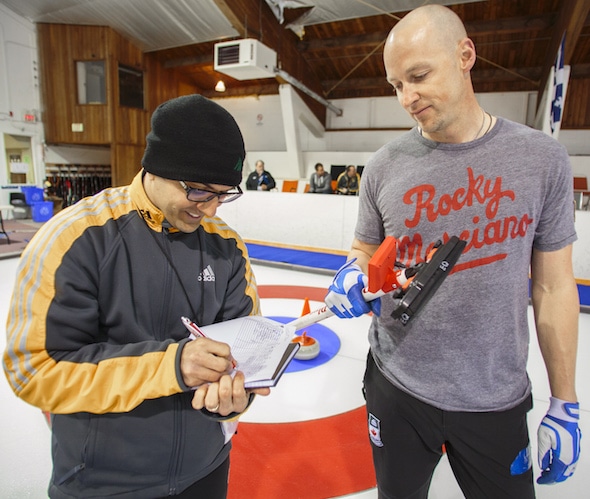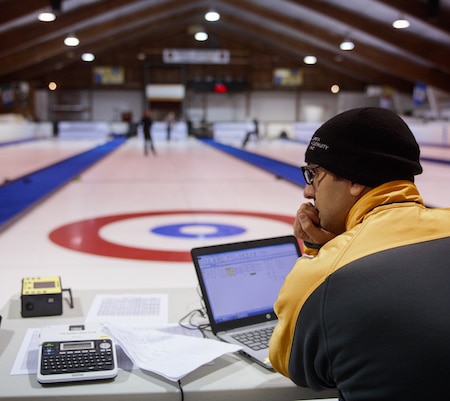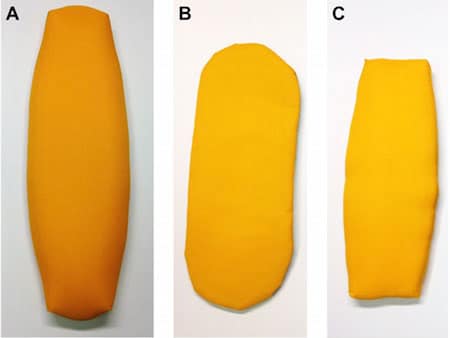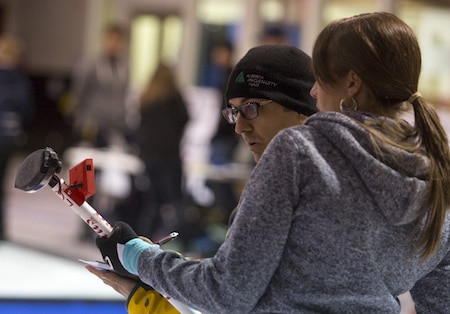Thiessen blog: How we got to Curling ABG (After BroomGate)
This past week, the World Curling Federation introduced numerous new sweeping and equipment rules during the World Curling Congress in Stockholm. This year’s congress was likely the most discussed Congress of the five held to date, after a year in which a massive sweeping conundrum hung over our sport.
 I was one of the athletes on hand in Kemptville, Ont., this past May for the WCF Sweeping Summit; therefore I was part of the athlete group that made recommendations, most of which were brought into the official WCF rule book in Stockholm. Flying to Ontario before the event, I was anxious as I didn’t know where we would end up at the end of our time in Kemptville.
I, like most athletes, was hopeful that we would find a solution that was the best for curling at the elite level. Last season, names were called, mud was thrown, brooms were sliding up and down the ice, and most of all I didn’t recognize the sport that we were playing. In the midst of all the drama and mayhem, I sat back and contemplated where we had got to.
It seemed like only a few months earlier, I was sweeping a draw to the button with Carter Rycroft to win the Tim Hortons Brier (BOTH of us sweeping the rock … novel idea) and now we are calling line by players’ names, counting the times that our brushes touched the ice, assessing the “sharpness” of our pads and generally not playing curling; we were playing sweeping. Draws around a guard (or hooked guards) were easily removed with hack weight and the game just wasn’t the same. All of the athletes who were in Kemptville, and I think all of those in attendance, including WCF staff, manufacturers, athletes and representatives from Member Associations around the world, wanted a sense of normalcy for the sport. We all hoped we could get there but weren’t sure where the path was going to lead us.
Before the Summit, a crucial survey was released for the public and athletes to fill out in regards to sweeping this past season. Although numerous points of view were witnessed, when the results were viewed, two overriding views were held by all groups, providing us clarity for our goals during the Summit:
I was one of the athletes on hand in Kemptville, Ont., this past May for the WCF Sweeping Summit; therefore I was part of the athlete group that made recommendations, most of which were brought into the official WCF rule book in Stockholm. Flying to Ontario before the event, I was anxious as I didn’t know where we would end up at the end of our time in Kemptville.
I, like most athletes, was hopeful that we would find a solution that was the best for curling at the elite level. Last season, names were called, mud was thrown, brooms were sliding up and down the ice, and most of all I didn’t recognize the sport that we were playing. In the midst of all the drama and mayhem, I sat back and contemplated where we had got to.
It seemed like only a few months earlier, I was sweeping a draw to the button with Carter Rycroft to win the Tim Hortons Brier (BOTH of us sweeping the rock … novel idea) and now we are calling line by players’ names, counting the times that our brushes touched the ice, assessing the “sharpness” of our pads and generally not playing curling; we were playing sweeping. Draws around a guard (or hooked guards) were easily removed with hack weight and the game just wasn’t the same. All of the athletes who were in Kemptville, and I think all of those in attendance, including WCF staff, manufacturers, athletes and representatives from Member Associations around the world, wanted a sense of normalcy for the sport. We all hoped we could get there but weren’t sure where the path was going to lead us.
Before the Summit, a crucial survey was released for the public and athletes to fill out in regards to sweeping this past season. Although numerous points of view were witnessed, when the results were viewed, two overriding views were held by all groups, providing us clarity for our goals during the Summit:
 With the help of the National Research Council, we started the testing plan, which included sweeping at a 45-degree angle to the running stone, both with and against the curl, as well as the perceived solution “straight across.” It didn’t take long to see results that we knew were out of scope; not only with our perceptions of normal curling physics as we knew them, but also out of scope for what the fans felt a sweeper’s capacity should be.
A controlled draw was thrown and scientifically tested to ensure accurate speed and distance measurements were taken. The control rock stopped in the full 12-foot, at or near the centerline. We then swept with multiple constructions that were in play and ones that were banned during this past season. After ensuring that the throw, with the same rock, had the same speed and release as the control rock, we saw the following:
With the help of the National Research Council, we started the testing plan, which included sweeping at a 45-degree angle to the running stone, both with and against the curl, as well as the perceived solution “straight across.” It didn’t take long to see results that we knew were out of scope; not only with our perceptions of normal curling physics as we knew them, but also out of scope for what the fans felt a sweeper’s capacity should be.
A controlled draw was thrown and scientifically tested to ensure accurate speed and distance measurements were taken. The control rock stopped in the full 12-foot, at or near the centerline. We then swept with multiple constructions that were in play and ones that were banned during this past season. After ensuring that the throw, with the same rock, had the same speed and release as the control rock, we saw the following:

Dr. Louis Poirier, Research Council Officer for the National Research Council, records measurements collected from a specialized broom with measuring sensors used by Nolan Thiessen. (Photo, courtesy National Research Council/Dan Gamache)
- A sweeper should not be able to unusually back up a rock
- A sweeper should not be able to slow down a rock by sweeping it
- Nobody ever swept straight across the rock. I looked up numerous old games on YouTube, including the 2000 Brier final, 2002 Olympic finals and 2004 Brier final, and nobody swept “straight across”
- People have swept very close to a snowplow in years past and yet the rocks weren’t darting all across the ice like they did last season

Dr. Louis Poirier analyzes data gathered from the various sweeping tests conducted at the North Grenville Curling Club in Kemptville, Ont. (Photo, courtesy National Research Council/Dan Gamache)
- When sweeping with the curl, we made the rock touch the boards around the second hogline
- When sweeping against the curl, we backed the rock off to stop in front of the house and be in line with the 12-foot as it had backed up and never actually reached a breaking point
- When sweeping straight across, we obtained similar line as the control throw, but the rock was hogged. We took the same throw that reached the house and stopped it in front of the hogline with the technique that was produced this past season as a solution






